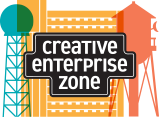In the Zone: Recycling links industrial heritage and creative future
We talk a lot about the remarkable concentration of creative enterprises, artists and nonprofits in the Creative Enterprise Zone. But this area is also home to a notable concentration of another type of creative enterprise that might not be the first to come to mind in conversations about creativity. This area is, and has long been, an epicenter of recycling operations.
The plumes of steam that emanate from the RockTenn paper mill on Wabash Avenue reference an important element of the Creative Enterprise Zone’s heritage and culture—standing as a testament to the inextricable link between the creative economy of the future and the industrial heritage of the past. That’s a connection we feel is worth embracing and preserving in the Creative Enterprise Zone.
There are practical reasons why artists and creative enterprises tend to cluster in historically industrial areas. Space is generally affordable and amenable to the needs of artists and creatives. But there seems be a meaningful symbolic link between creative enterprises and industry, as well.
In a sense, manufacturing and industry are archetypically “creative.” The designed generation of something new is a basic function of creativity. Industry is, at a fundamental level, systematically creative.
If industry is creative because it generates something new, then recycling takes things a step further by using something old to create something new.
Here are six recycling operations you might not have known about in the Creative Enterprise Zone.
Rohn Industries
For 30 years, Rohn Industries has helped businesses increase recycling with the aim of achieving zero waste. Today’s offices are filled with materials that need to be tossed, and much of it, including fluorescent lightbulbs, computers, printers and other electronics can be difficult to dispose of responsibly and affordably. With their GreenFuel program, Rohn Industries picks up waste that other recyclers cannot, and transports it to a plant that turns it into small pellets that get used in place of coal. The pellets generate similar heat output to coal, but with drastically reduced emissions. Rohn Industries helps businesses understand the potential for recycling, learn the best methods, and achieve even the loftiest of sustainability goals.
Bro-Tex, Inc.
Originally founded in 1923, Bro-Tex, Inc. has pioneered the use of new processes and technologies that allow them to recycle post consumer carpet. You can drop off your old carpet directly to their plant in the Creative Enterprise Zone at 800 N Hampden, or through their network of carpet collection centers. For every 1,000 square yards of carpet that is recycled, you can help save 440 gallons of oil, 10,000,000 BTU of energy and divert 4,500 lbs. of waste from landfills, according to the Carpet America Recovery Effort. Before the development of these technologies, there was no easy way to get rid of old carpet in a way that kept it out of the landfill. Now the materials from your old carpet could become new carpet, carpet pad, floating treatment for wetlands, acoustic matting or even as an energy substitute for natural gas and coal.
Midwest Floating Islands
Based out of the same location as Bro-Tex, Midwest Floating Islands is making waves in the effort to preserve the health and integrity of natural bodies of water throughout the region. Midwest Floating Islands, LLC specializes in manufacturing and distributing BioHaven® floating islands. These man-made islands are made of recycled bottles and “bio-mimic” natural floating wetlands in cleaning nutrient-polluted waters and providing habitat for fish, waterfowl and other aquatic species. They are being used all over the world to revive sick lakes, and strengthen the bio-ecosystems of other bodies of water.
RockTenn
With locations in the U.S., Canada, Mexico, Chile and Argentina, RockTenn is one of North America’s leading providers of packaging materials. At their mill in the Creative Enterprise Zone, RockTenn processes a thousand tons per day, making it the largest paper recycler in the Midwest. The plant at 2250 Wabash Ave has been in operation since 1908. Formerly known as Waldorf Recycling, RockTenn purchased the mill in 1996.
Recycling Association of Minnesota
Founded in 1989 with the goal of educating Minnesotans about recycling, RAM continues to work to promote resource conservation through waste prevention, reuse, recycling, composting and purchasing practices. Located on Wabash Avenue, the organization holds conferences, convenes educational forums, disseminates information, creates unique recycling programs and more. In recent years, RAM has created even more education opportunities and niche recycling programs for the general public, including the Recycle MORE Minnesota Education Campaign, Key to Recycle™, Recycle Your Holidays™, and more. These programs have made it easier to recycle things like keys, holiday lights, and shoes. In the Midway, they are especially well-known for their annual rain barrel and compost bin distributions that take place every Spring.
Carl Bolander & Sons Co.
Established in 1924 by Swedish Immigrant Carl Bolander, the company has grown to be recognized as one of the Midwest’s leaders in specialty contracting business. In addition to offering a wide range of construction site services like earthwork, demolition and underground utilities, they also offer an array of environmental services including site remediation and concrete recycling. Following the tragic collapse of the I-35 bridge in 2005, Bolander & Sons was enlisted to remove the debris from the site, bringing all the concrete from the bridge to the Vandalia Crusher site at 2035 Capp Road in the Creative Enterprise Zone.
Know of other recycling efforts here? Let us know.

